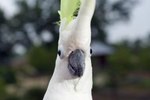
Like most animals, parakeets communicate both vocally and through body language. These birds, including the ever-popular budgies, typically cherish the companionship of their owners. No two birds are exactly alike, but the different ways in which they communicate are generally similar. The relationship you share will be easier to navigate and more meaningful if you learn what your parakeet's mannerisms and vocalizations mean.
Biting
A parakeet communicates fear quite clearly: by biting. If you reach into your budgie's cage and he bites, or if he bites a guest whom he doesn't recognize, he isn't trying to be rude -- he's just afraid. Don't mistake biting inanimate objects with fear, though. For example, if he bites the bars of his cage, it may simply be out of boredom, or for exercise, or because of an ailment. Give him a hard toy or treat designed for parakeets to see if he stops; otherwise schedule an avian vet visit. Your responsibilities are to learn how to handle your bird properly and gingerly, and to socialize him early on to ward off fearfulness.
Speaking Your Language
While a parakeet can communicate by repeating what you say, don't assume he understands what it means. Parakeets are born imitators; with repetition, yours may start speaking English right back to you. His ability to imitate isn't predicated on understanding the meaning of the words, though, so think of it less like a conversation and more like a trick. When it comes to understanding how your bird truly feels, you're better off paying more attention when he speaks his own language.
General Sounds
While parakeets aren't as loud as some other domesticated birds, they boast a full repertoire of squawks, cries and warbles for communicating their feelings. They are typically accustomed to living among other parakeets, even in domestic environments like pet shops, so certain vocalizations are relatively common. For example, many parakeets warble or coo as a sign of contentment. Alternatively, if your parakeet emits a high-pitched cry, he feels frightened, frustrated or lonely -- he may make this sound to communicate that he needs time with you outside of his cage.
Body Language
A parakeet communicates feelings through body language, so pay attention to your bird's behavior if you want to understand his mood. For example, like other species of parrot, a parakeet may lower his heads, fluff up his feathers and partially raise his wings as a sign that he wants to be picked up. He may flap his wings as a way of getting your attention, or shake his tail as a sign that he is excited and ready to play. The best way to learn how your own parakeet communicates is to pay attention to his frequently used signs and give him what he needs.
References
Photo Credits
-
BananaStock/BananaStock/Getty Images
Writer Bio
Tom Ryan is a freelance writer, editor and English tutor. He graduated from the University of Pittsburgh with a degree in English writing, and has also worked as an arts and entertainment reporter with "The Pitt News" and a public relations and advertising copywriter with the Carnegie Library of Pittsburgh.



